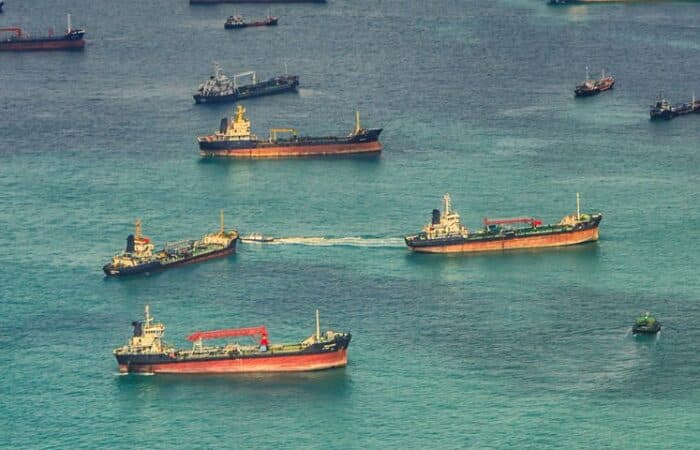AIS Gaps and AIS Handshakes
What are AIS Gaps and AIS Handshakes?
AIS gaps and AIS handshakes are two activities that make it difficult to track the movements of a vessel. AIS gaps are periods in time when an AIS transponder stops emitting signals. It may or may not indicate dark activity (depending on if the gap is intentional or not). AIS handshakes occur when two ships trade AIS transponders. It is always a sign of ships involved in some type of deceptive shipping practice (DSP).
Understanding AIS Transmission Gaps
Every ship sails with an automatic identification system (AIS), which transmits a vessel’s location, identification number, and other details. AIS gaps are periods of time when the ship stops transmitting its signal, making it impossible to track the signal. Sometimes this happens naturally due to transmission issues or poor reception, etc. But it is also an extremely common practice among ships that are involved in dark activities, including smuggling cargo and human rights violations.
With its transponder turned off, the ship becomes difficult to track until the transmission is reactivated. This tactic is often used to hide stops in countries that are under sanction, or if ships are involved in illegal ship-to-ship transfers.
But, not all AIS gaps are executed to hide illegal activity. Most gaps occur when the transmission simply isn’t picked up by the sensor. This can be caused by a number of factors, including:
- The ship is in an area without terrestrial stations and beyond satellite coverage
- There is a high volume of ships in an area, and the signals get jammed
- Poor weather conditions
These missed transmissions are known as lost AIS signals since the ship didn’t stop transmitting its location. But, without the right tools, it can be difficult to determine whether an AIS gap was a missed transmission, or indicative of deceptive shipping practices.

What are AIS Handshakes?
Unlike AIS gaps, which don’t necessarily mean the ship is acting suspiciously, AIS handshakes are a tactic used for illegal activities. This involves two vessels — one “clean” and one “dirty” — often involved in illicit activities like smuggling, illegal fishing, or loading or unloading cargo in sanctioned countries. The two vessels sail in close proximity to each other and switch their AIS identifiers.
Here’s how it typically works:
- Initial contact: the “dirty” and “clean” vessels meet at a specific location
- AIS swap: the “dirty” vessel assumes the AIS identity of the “clean” vessel. This may involve technical manipulations to switch the AIS transponder codes, or manually alter AIS data
- Separation: after swapping AIS identities, the “clean” vessel might turn off its AIS and proceed to its legitimate destination, effectively going “dark.” The “dirty” vessel continues its illicit activities, but appears “clean” because it’s using the AIS identity of the other vessel
- Return and swap back: upon completing their separate journeys, the two vessels meet again to switch back their AIS identities
This kind of activity is illegal and a breach of maritime law. It is done to mislead authorities, making it difficult to track and apprehend vessels involved in illegal activities. Such practices compromise the integrity of AIS data and present significant risks to maritime safety, security, and environmental protection.
Why Ships Use AIS Transmitters
Ships that are over 300 tons are required by the International Maritime Organization to activate their AIS at all times. AIS transmitters help track ships and prevent collisions. The AIS makes it easier for ships to detect other ships in the region, so they can keep a safe distance. The signal not only reports on the ship’s location, but also its bearing and speed, information about the ship itself, and voyage information.
While tracking ships wasn’t the original reason for the AIS requirement, it has evolved into one of its primary functions (if not the primary one).
Legitimate Reasons for AIS Gaps
As mentioned, ships sometimes lose their AIS signal due to being in extremely remote areas, or extreme weather events.
Temporarily turning off the AIS transmission is a major security issue. There are several reasons why a ship that is not involved in any illegal activity would stop transmitting.
At times, ships go dark to increase the safety of the vessel. For example, if a ship is sailing through an area where pirates are sailing, turning off the AIS will hide the vessel, protecting it from pirates who want to steal the cargo. Another real-life example took place in 2019 at the Strait of Hormuz, where Iran was seizing ships that entered its waters. By creating an AIS gap, ships were able to avoid detection and sail safely to international waters.
How to Limit AIS False Flags
With the right tools in place, organizations can recognize the difference between legitimate AIS gaps and those performed to hide deceptive shipping practices.
Traditionally, when a ship has an AIS gap, a compliance team is called in to investigate the situation. This includes checking for a number of illegal activities, including:
- Docking in a sanctioned country
- Executing an illegal ship-to-ship transfer
- Meeting with a sanctioned entity
- Entering an IUU fishing zone
These investigations require a significant amount of people-power and resources, especially when overseeing hundreds of vessels.
An Easy Solution
A far easier and more cost-effective solution for staying ahead of AIS gaps, AIS handshakes, and other deceptive shipping practices, is to use advanced Maritime AI™ technology. It collects thousands of data points, not only from the vessel itself, but also from the crew, ship owners, cargo onboard, weather, and other ships in the region. By combining all of this data, it can reduce false positives, enabling the investigative team to focus their efforts on vessels that are more likely to be acting suspiciously.







